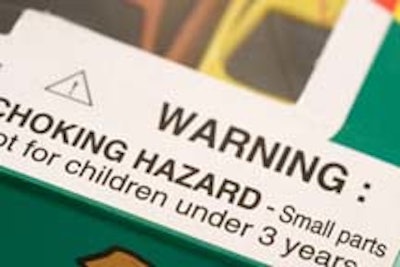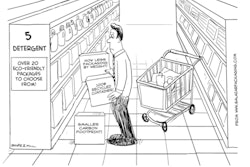
The consumer packaged good that poses no hazard whatsoever is rare, if not nonexistent; therefore, the need to warn presents itself throughout the CPG industry. Packaging personnel should have a fundamental understanding of the theory of warnings: Packaging is a medium through which warnings are conveyed.
A hazard represents the package product’s ability to inflict harm—most notably to people, but also including to animals, plants, and even inanimate objects. There’s a three-phase process to packaged product safety:
Design the hazard out of the product;
Provide safeguards against hazards that can’t be designed out; and
3) Warn against remaining hazards.
Packaging, however, is not limited to phase 3, warnings. A packaged product, no matter how integrated, has two components: product and package, either of which can render the packaged product hazardous. Two classic examples of packaging's role in that regard are the packages that predated the eras of child-resistance and tamper-evidence. It’s always smart to ask at phase 1 whether the packaging is deficient from a safety perspective.
Furthermore, packaging can play a role in phase 2. Keeping with the previous examples, the large and growing variety of child-resistant and tamper-evident packaging functions as safeguards against the hazards stemming from accessibility to children and susceptibility to tampering.
By the time that the process reaches step 3, the rightful role of the packaging professional should extend beyond providing the billboard for the warnings. Packaging should be one of the disciplines, including product development, engineering, marketing, and legal, that provides input into the warnings decision. When making that input, the packaging professional should utilize a systems approach built around several fundamental questions.
What is a warning?
Not that there is a universally accepted definition, and without going the “according to Webster” route, a warning is a communication that informs of a hazard with specificity sufficient to produce a desired effect on behavior. The definition translates to letting a person know of potential harm, well enough that the person can take the proper action to avoid that harm. A warning is a communication and a key function of packaging is communication, packaging as media being the natural association between the two.
When is a warning required?
In the abstract, the answer is whenever there is a hazard linked to the packaged product. In concrete terms, however, hazards range from the obvious to the inconspicuous, complicated further by the fact that not all instances of the former require warnings and not all instances of the latter can reasonably be the subjects of warnings. Here’s where prioritizing comes in. Hazards should be ranked in terms of their severity and their probability of occurrence; in other words, the degree of harm that can be inflicted and how likely the infliction. Whereas one cannot be expected to warn of every possibility, one should warn against harm resulting not just from intended use, but also from reasonably foreseeable misuse.
In that regard, the packaging professional might be able to compensate for the blind spots and special interests of others involved in the warnings decision. For example, product development and engineering might not regard certain product features as hazardous—not due to a disregard for safety, but rather from a lack of objectivity owing to from-conception familiarity. And, even when those types acknowledge a hazard, they might—albeit in good faith—devise warnings that are too seeped in technical jargon.
By contrast, the marketing folks might devise warnings that ostensibly are consumer-friendly, but in fact, soft-pedal the hazards, concerned that to be more explicit might dissuade the consumer from purchasing.
Fortunately, the packaging professional, accustomed to working across practically every discipline within the company, should be capable of a perspective that’s both encompassing and reconciling.
What should be the format and content of a warning?
Format relates to how the warning is structured, content relates to what the warning says. In some instances, format and content are governed by regulation, the Food & Drug Administration being a prime example. Regulations, however, don’t automatically reduce the warning decision to a template, since some are structured broadly, granting companies leeway as to how, not whether, they comply.
The many packaged product categories that are not under specific regulatory requirements, nonetheless, have a duty to warn, if such warning is warranted. Companies within those categories, as well as companies under leeway-granting regulations, should base the warning format and content on certain widely-accepted principles, namely that the warnings should contain a signal word; a hazard statement; a consequence statement; and an instructions statement.
The signal word—Danger, Warning, Caution—sometimes accompanied by a pictogram (i.e. the proscribing diagonal within a circle) or an icon (i.e., exclamation point within a triangle) should be chosen to reflect the seriousness of the hazard. The hazard statement should identify the specific hazard. The consequences statement should tell what harm the hazard can inflict. The instruction statement should tell what to do to avoid the hazard and (if necessary) what emergency measures to take.
No matter how effectively the aforementioned components are combined, the warning will not serve its purpose if it is not seen. The warning must be conspicuous, made to stand out from the surrounding copy and graphics of the packaging. It’s a matter of font placement, size, color, etc.
A final word to the wise
To paraphrase the introductory sentence, it’s more likely than not that a given packaged product embodies a hazard. The differentiators are the conditions under which the hazard can manifest itself.
It’s good corporate citizenship to take every feasible measure to place safe packaged products into the commercial stream. It’s a responsibility that can’t be fulfilled through comfortable, self-serving assumptions.
In today’s litigious environment, often it’s a product liability lawsuit that shakes a company out of its belief that its product is either harmless or that it carries adequate warnings. Take the case of the marketer of microwavable popcorn, sued for not warning that steam escaping upon opening the bag can damage the retina. Take, too, the case of the marketer of hot dogs, sued for not warning that a child can choke on a bitten piece.
Those cases are exampled without commentary to their merits; that’s the job of a judge or jury. Rather, they are cited because they represent products not routinely regarded as hazardous. If they aren’t exempt, what products are?
Given the diverse communication demands that your packaging might already be shouldering, it’s tempting not to look for another, in the form of warnings; yet, you’d be wise to ask whether a present warning is effective, or in the absence of a warning, whether there should be one. You have no excuse now. You’ve been warned.
Before becoming a packaging consultant, Sterling Anthony worked for Fortune 500 food, healthcare, and automotive companies, and has taught packaging at the university level. He welcomes your comments by phone, 313/531-1875 or by e-mail, [email protected]. His Web site is www.pkgconsultant.com.
A hazard represents the package product’s ability to inflict harm—most notably to people, but also including to animals, plants, and even inanimate objects. There’s a three-phase process to packaged product safety:
Design the hazard out of the product;
Provide safeguards against hazards that can’t be designed out; and
3) Warn against remaining hazards.
Packaging, however, is not limited to phase 3, warnings. A packaged product, no matter how integrated, has two components: product and package, either of which can render the packaged product hazardous. Two classic examples of packaging's role in that regard are the packages that predated the eras of child-resistance and tamper-evidence. It’s always smart to ask at phase 1 whether the packaging is deficient from a safety perspective.
Furthermore, packaging can play a role in phase 2. Keeping with the previous examples, the large and growing variety of child-resistant and tamper-evident packaging functions as safeguards against the hazards stemming from accessibility to children and susceptibility to tampering.
By the time that the process reaches step 3, the rightful role of the packaging professional should extend beyond providing the billboard for the warnings. Packaging should be one of the disciplines, including product development, engineering, marketing, and legal, that provides input into the warnings decision. When making that input, the packaging professional should utilize a systems approach built around several fundamental questions.
What is a warning?
Not that there is a universally accepted definition, and without going the “according to Webster” route, a warning is a communication that informs of a hazard with specificity sufficient to produce a desired effect on behavior. The definition translates to letting a person know of potential harm, well enough that the person can take the proper action to avoid that harm. A warning is a communication and a key function of packaging is communication, packaging as media being the natural association between the two.
When is a warning required?
In the abstract, the answer is whenever there is a hazard linked to the packaged product. In concrete terms, however, hazards range from the obvious to the inconspicuous, complicated further by the fact that not all instances of the former require warnings and not all instances of the latter can reasonably be the subjects of warnings. Here’s where prioritizing comes in. Hazards should be ranked in terms of their severity and their probability of occurrence; in other words, the degree of harm that can be inflicted and how likely the infliction. Whereas one cannot be expected to warn of every possibility, one should warn against harm resulting not just from intended use, but also from reasonably foreseeable misuse.
In that regard, the packaging professional might be able to compensate for the blind spots and special interests of others involved in the warnings decision. For example, product development and engineering might not regard certain product features as hazardous—not due to a disregard for safety, but rather from a lack of objectivity owing to from-conception familiarity. And, even when those types acknowledge a hazard, they might—albeit in good faith—devise warnings that are too seeped in technical jargon.
By contrast, the marketing folks might devise warnings that ostensibly are consumer-friendly, but in fact, soft-pedal the hazards, concerned that to be more explicit might dissuade the consumer from purchasing.
Fortunately, the packaging professional, accustomed to working across practically every discipline within the company, should be capable of a perspective that’s both encompassing and reconciling.
What should be the format and content of a warning?
Format relates to how the warning is structured, content relates to what the warning says. In some instances, format and content are governed by regulation, the Food & Drug Administration being a prime example. Regulations, however, don’t automatically reduce the warning decision to a template, since some are structured broadly, granting companies leeway as to how, not whether, they comply.
The many packaged product categories that are not under specific regulatory requirements, nonetheless, have a duty to warn, if such warning is warranted. Companies within those categories, as well as companies under leeway-granting regulations, should base the warning format and content on certain widely-accepted principles, namely that the warnings should contain a signal word; a hazard statement; a consequence statement; and an instructions statement.
The signal word—Danger, Warning, Caution—sometimes accompanied by a pictogram (i.e. the proscribing diagonal within a circle) or an icon (i.e., exclamation point within a triangle) should be chosen to reflect the seriousness of the hazard. The hazard statement should identify the specific hazard. The consequences statement should tell what harm the hazard can inflict. The instruction statement should tell what to do to avoid the hazard and (if necessary) what emergency measures to take.
No matter how effectively the aforementioned components are combined, the warning will not serve its purpose if it is not seen. The warning must be conspicuous, made to stand out from the surrounding copy and graphics of the packaging. It’s a matter of font placement, size, color, etc.
A final word to the wise
To paraphrase the introductory sentence, it’s more likely than not that a given packaged product embodies a hazard. The differentiators are the conditions under which the hazard can manifest itself.
It’s good corporate citizenship to take every feasible measure to place safe packaged products into the commercial stream. It’s a responsibility that can’t be fulfilled through comfortable, self-serving assumptions.
In today’s litigious environment, often it’s a product liability lawsuit that shakes a company out of its belief that its product is either harmless or that it carries adequate warnings. Take the case of the marketer of microwavable popcorn, sued for not warning that steam escaping upon opening the bag can damage the retina. Take, too, the case of the marketer of hot dogs, sued for not warning that a child can choke on a bitten piece.
Those cases are exampled without commentary to their merits; that’s the job of a judge or jury. Rather, they are cited because they represent products not routinely regarded as hazardous. If they aren’t exempt, what products are?
Given the diverse communication demands that your packaging might already be shouldering, it’s tempting not to look for another, in the form of warnings; yet, you’d be wise to ask whether a present warning is effective, or in the absence of a warning, whether there should be one. You have no excuse now. You’ve been warned.
Before becoming a packaging consultant, Sterling Anthony worked for Fortune 500 food, healthcare, and automotive companies, and has taught packaging at the university level. He welcomes your comments by phone, 313/531-1875 or by e-mail, [email protected]. His Web site is www.pkgconsultant.com.


























